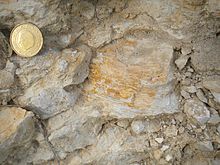Ligérien
The Ligérien is a geological lower stage of the Turonian . The term is used for sedimentary layers of the sub-turon in western France .
etymology
The name Ligérien is derived from the Latin Ligera for the Loire River .
distribution
The Ligérien is found in the Touraine ( Paris Basin ) near Saumur along the Loire ( type locality of the Turonium), but it also occurs in the northern Aquitaine Basin .
stratigraphy

The Ligérien, abbreviated C3a on geological maps of France, is the lowest subgrade of the Turonian and immediately follows the Cenomanian . It is overlaid by Angoumien .
In the northern Aquitaine Basin, the Ligérien shows the following sequence as a Villars formation :
At its base, the Ligérien begins with an alternation (in the meter range) of white, chalky limestone and rather thin, more marbled gray intermediate layers. The marl layers gradually recede towards the hanging wall and then give way to white, massive, very homogeneous, cryptocrystalline chalk limestone (thickness 5 to 10 meters).
The boundary layer to the Cenomaniac still has a detritic character and can contain larger quartz grains , smaller pebbles as well as ground lamellibranchia and echinodermic remains.
The stratification of the Ligérien, if recognizable, is typically bulbous to flat. The limestones usually disintegrate into short, prismatic columns. Because they are easy to erode, they form the foot of the steep face of the much more competent Angoumien. In arable farming, these lime layers are used to grow grain.
The transition to the subsequent angoumia is very progressive, but can be defined on the basis of the first detritic interventions, peloids of various sizes and frequent annelid tubes as well as the disappearance of the pelagic foraminifera. The lowest 5 to 8 meters of the Angoumien can consequently only be distinguished from the actual Ligérien; cartographically, they are therefore usually still included in the Ligérien.
The thickness of the Ligérien in the northern Aquitaine Basin is usually between 15 and 20 meters, but can also swell up to 42 meters in syncline areas.
Fossil content
The Ligérien has a relatively poor fossil fauna . It essentially consists of lamellibranchia such as Arca noueliana ( ark mussel ), Cardium productum ( cockle ), Exogyra columba ( oyster ) and Inoceramus labiatus ( inocerame ), gastropods ( Pleurotomaria galliennei ), hexacorals and bryozoa , and annelids appear in the upper area added. Ammonites such as Collignoniceras peramplum , Eutrophoceras sublaevigatus , Lewesiceras peramplum , Mammites revelieri and Spathites reveliereanum and nautiloids such as Nautilus sublaevigatus are rarely found. The microfauna is also not very diversified, with ostracods (in marls), textulariida and pelagic foraminifera ( Hedbergella delrioensis , Heterohelix , Globotruncana ) predominating . Furthermore occur Discorbidae and benthic foraminifera as Dorothia sp. , Marsonnella oxycona , Eggerella sp. , and Tritaxia sp. .
The occurrence of worms and pyrite bulbs in the chalk limestone is very common .
Deposit conditions

The very finely ground bioclastic remains, the pelagic foraminifera and the occasional ammonite findings suggest a deposit environment that represents the transition to the open sea.
The sea level was rising globally during the Ligérien and reached a transgressive maximum towards the end of the lower stage, only to drop again during the Angoumien (the Angoumien is a facies much closer to the coast). The water temperatures were very high shortly before their optimum in the Oberturon.
Period
The Ligérien is largely at the same time as the Unterturon ; it therefore represents the period 93.5 to 92.0 million years BP .
The Ligérien immediately follows the Oceanic Anoxic Event OAE-2 , which ended the Cenomaniac (and wiped out half of the Ammonite Taxa).
tectonics

In addition to the common fractures and faults , as well as the rarer horizontal shifts (see figure above), the Ligérien has plenty of stylolites and pressure cones reminiscent of elephant feet (down to the decimeter), which are lined with belts of armor . The latter are likely to have been applied during diagenesis due to differential overload pressures.
literature
- M. Cassoudebat, J.-P. Platel: Sédimentologie et paleogéographie du Turonien de la bordure septentrionale du bassin aquitain . In: Bulletin BRGM, (2), section I, n ° 2 . 1973, p. 85-102 .
- F. Gradstein, J. Ogg, A. Smith, A .: A Geologic Time Scale 2004 . Cambridge University Press, ISBN 0-521-78673-8 .
- J.-P. Platel et al .: Feuille Périgueux (Ouest) . In: Carte géologique de la France at 1/50 000 . BRGM, 1989.